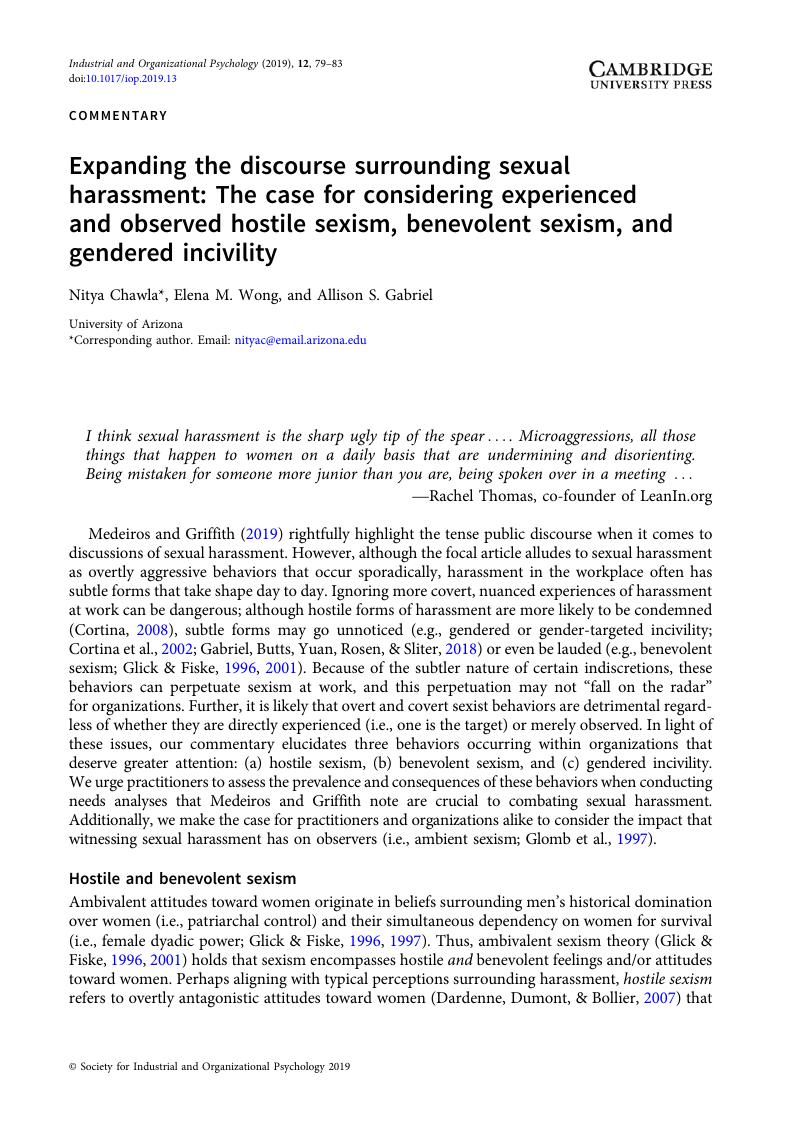Crossref Citations
This article has been cited by the following publications. This list is generated based on data provided by Crossref.
Zelin, Alexandra I.
and
Magley, Vicki J.
2020.
Handbook of Interpersonal Violence and Abuse Across the Lifespan.
p.
1.
Chawla, Nitya
Gabriel, Allison S.
O’Leary Kelly, Anne
and
Rosen, Christopher C.
2021.
From #MeToo to #TimesUp: Identifying Next Steps in Sexual Harassment Research in the Organizational Sciences.
Journal of Management,
Vol. 47,
Issue. 3,
p.
551.
Zelin, Alexandra I.
and
Magley, Vicki J.
2022.
Handbook of Interpersonal Violence and Abuse Across the Lifespan.
p.
3941.
Gabriel, Allison S.
Arena, David F.
Calderwood, Charles
Campbell, Joanna Tochman
Chawla, Nitya
Corwin, Emily S.
Ezerins, Maira E.
Jones, Kristen P.
Klotz, Anthony C.
Larson, Jeffrey D.
Leigh, Angelica
MacGowan, Rebecca L.
Moran, Christina M.
Nag, Devalina
Rogers, Kristie M.
Rosen, Christopher C.
Sawyer, Katina B.
Shockley, Kristen M.
Simon, Lauren S.
and
Zipay, Kate P.
2022.
Research in Personnel and Human Resources Management.
p.
205.
Smart, Rebekah
Dilley, Alexandria
Ward, Melissa L.
and
Chopra, Sapna B.
2022.
Therapists and #MeToo: A Qualitative Survey of Personal Reactions and Professional Experiences.
Women & Therapy,
Vol. 45,
Issue. 1,
p.
74.
Zelin, Alexandra I.
Branda, Brittany
and
Tino, Riley
2022.
How Do You Define Sexual Harassment?: Why Context Matters.
Violence Against Women,
Vol. 28,
Issue. 14,
p.
3438.
Banner, Francine
Martin, Lisa
Aronson, Pamela
Bradley, Grace
Jaffal, Islam
and
Linker, Maureen
2022.
Can Respectful Employees Create Equitable Institutions? Promoting a Culture of Respect in the Higher Education Workplace.
Feminist Criminology,
Vol. 17,
Issue. 3,
p.
384.
Hall, Taylor K.
and
Dhanani, Lindsay Y.
2023.
Cloaked in Kindness: Bystander Responses to Witnessed Benevolent and Hostile Sexism.
Sex Roles,
Vol. 89,
Issue. 11-12,
p.
658.
Warren, Catherine
Wax, Amy
Brush, Olivia T.
Magalona, Joie
and
Galvez, Gino
2023.
Development and validation of the Benevolent Sexism in the Workplace scale.
Journal of Occupational and Organizational Psychology,
Vol. 96,
Issue. 3,
p.
473.
Pazzaglia, Federica
Sonpar, Karan
Kulkarni, Mukta
and
Maheshwari, Navya
2024.
Tokens or Trailblazers: Identity Construction of Occupants of New Inclusion-Driven Roles.
Journal of Management,
Chawla, Nitya
and
Gabriel, Allison S.
2024.
From crude jokes to diminutive terms: Exploring experiences of hostile and benevolent sexism during job search.
Personnel Psychology,
Vol. 77,
Issue. 2,
p.
747.



